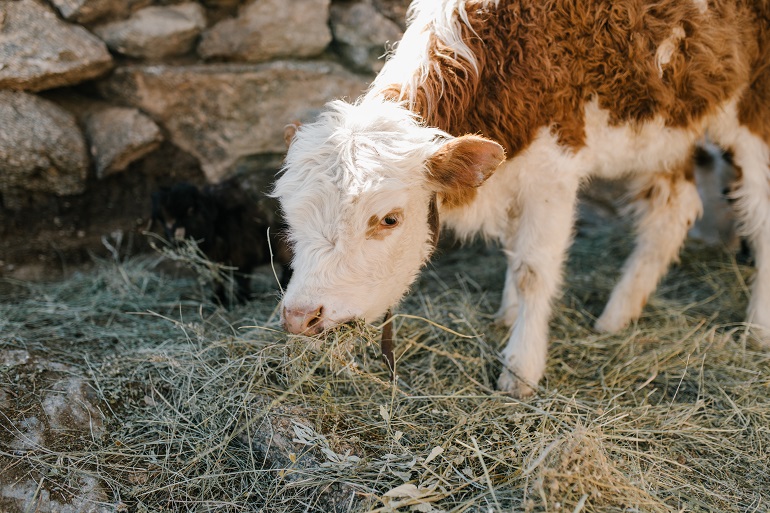Nutrition of Calf
Colostrum (either dam’s colostrum or mixed colostrum from first milking of older cows) fed to calves as soon after birth as possible (ideally within 30 minutes and certainly within 4 hours) protects against disease. Early feeding of colostrum at 4 to 5% of birth weight is necessary because:
New-born calves have no antibodies to provide natural protection against disease until they receive colostrum.
Calves’ ability to absorb immunoglobulins (the disease protection component) is substantially reduced after 24 – 36 hours. Calves may become infected with highly disease-causing bacteria immediately after birth. Colostrum is a concentrated source of ready available nutrients. Within the first 24 hours after birth, calves should receive 12-15 per cent of their birth weight as first-milking colostrum. Half of this should be within 4 to 6 hours after birth, and the remaining half 12 hours later. Hand feeding of colostrum through a nipple bottle or oesophageal feeder is preferred to nursing and assures that the calf receives the required amount of colostrum. Most calves require 200 to 300 grams of immunoglobulin to acquire passive immunity. Low-quality, bloody or mastitis-containing colostrum should not be fed.
Excess colostrum is highly nutritious and can be fed after the calf has received the first milk colostrum during the first 24 hours of life. Undiluted excess colostrum contains about a third more solids than milk or reconstituted milk replacer and is highly digestible. Storage and subsequent use of excess colostrum are highly desirable. Make sure water is fresh, and pails are cleaned daily.
Calves offered water during the liquid feeding period (birth to 4 weeks) tend to consume more Starter and perform better than calves just fed the liquid feed.
Summary of feeding program in early life. A carefully planned feeding program is necessary for calves to thrive and grow. The feeding program can be summarized as follows:
- Day 1 Dam’s colostrum
- Day 2 Dam’s colostrum
- Day 3 Dam’s colostrum
- Day 4 Liquid feed of choice, introduce Starter and water
- Day 5 to weaning Continue liquid feeding program
Weaning to 12 weeks Starter introduce forage if not previously fed
It may be fed fresh; frozen, or stored, then thawed prior to feeding; or stored as sour (fermented) colostrum. Naturally fermented sour colostrum, stored in clean containers away from excessive heat, is an acceptable feed for calves over 3 days old.
Colostrum supplements. Commercial colostrum supplements may be useful. Efficacy may differ according to the type of product and conditions of use. These preparations may be useful to enhance the antibody content of low-quality colostrum and increase low antibody titters in calves.
Hay or silage for the young calf. While calves may begin nibbling on good quality hay as early as 5 to 10 days of age, feeding forages before 8 to 10 weeks of age is unnecessary. If forages are inconvenient because of the housing and management system, it may be desirable to incorporate a forage factor (more fibre) into the starter ration. Extremely high moisture silages and pastures should not be fed before 3 months of age because the high moisture content can limit intake and growth. Low-moisture hay is acceptable if it is kept fresh.
Water. Water can be offered free choice starting on day 4 of life. Calves fed limited liquid (such as in a once-a-day feeding program) should receive supplemental water, especially during warm weather.
If quality feeds are used and fed in satisfactory amounts under good conditions of management in the program described, replacement calves that are fast-growing, vigorous, and healthy should result. Minerals are essential and should be provided as mineral licks. Sticking up a mineral block inside the calf pen is the most convenient method. Fresh, clean water must be provided daily.
Calf Digestive System
The rumen, reticulum, and abomasum are undeveloped at birth and during the first few weeks of life. In contrast to the mature cow, in the calf, the abomasum is the largest compartment of the stomach. At this stage of life, the rumen is nonfunctional and some feeds digested by the adult cannot be used by the calf. During nursing or feeding from a bucket, milk bypasses the rumen via the oesophagal groove and passes directly into the abomasum. Reflex action closes the groove to form a tube-like structure which prevents milk or milk replacer from entering the rumen. When milk is consumed very rapidly, some may overflow into the rumen.
As long as the calf remains on milk, the rumen remains undeveloped. When calves begin consuming grain and forage, a microbial population becomes established in the rumen and reticulum. End products of microbial fermentation are responsible for the development of the rumen. This occurs as early as 3 weeks of age with most feeding programs. If grain feeding with or without forage is started during the first few weeks of life, the rumen will become larger and heavier and will begin functioning like the adult’s when the calf is about 3 months of age.
Find more information in the Books of the Author: Success in Agribusiness
Farm Animal (Cattle) Nutrition
Feeding Systems of Farm Animals
Protein Supplements in Animal Feed
Livestock Feed selection – Evaluation of Feed Ingredients
Management of an intensive (Zero) Grazing System
Trace Minerals: The key to Immunity for Farm Animals
Dairy Cow Nutrition on different Lactation Cycles
Nutrition of Calf
Training Livestock Farmers for Sustainability and Food Security









































































